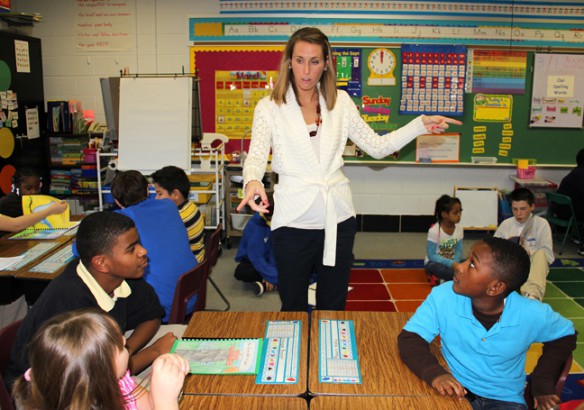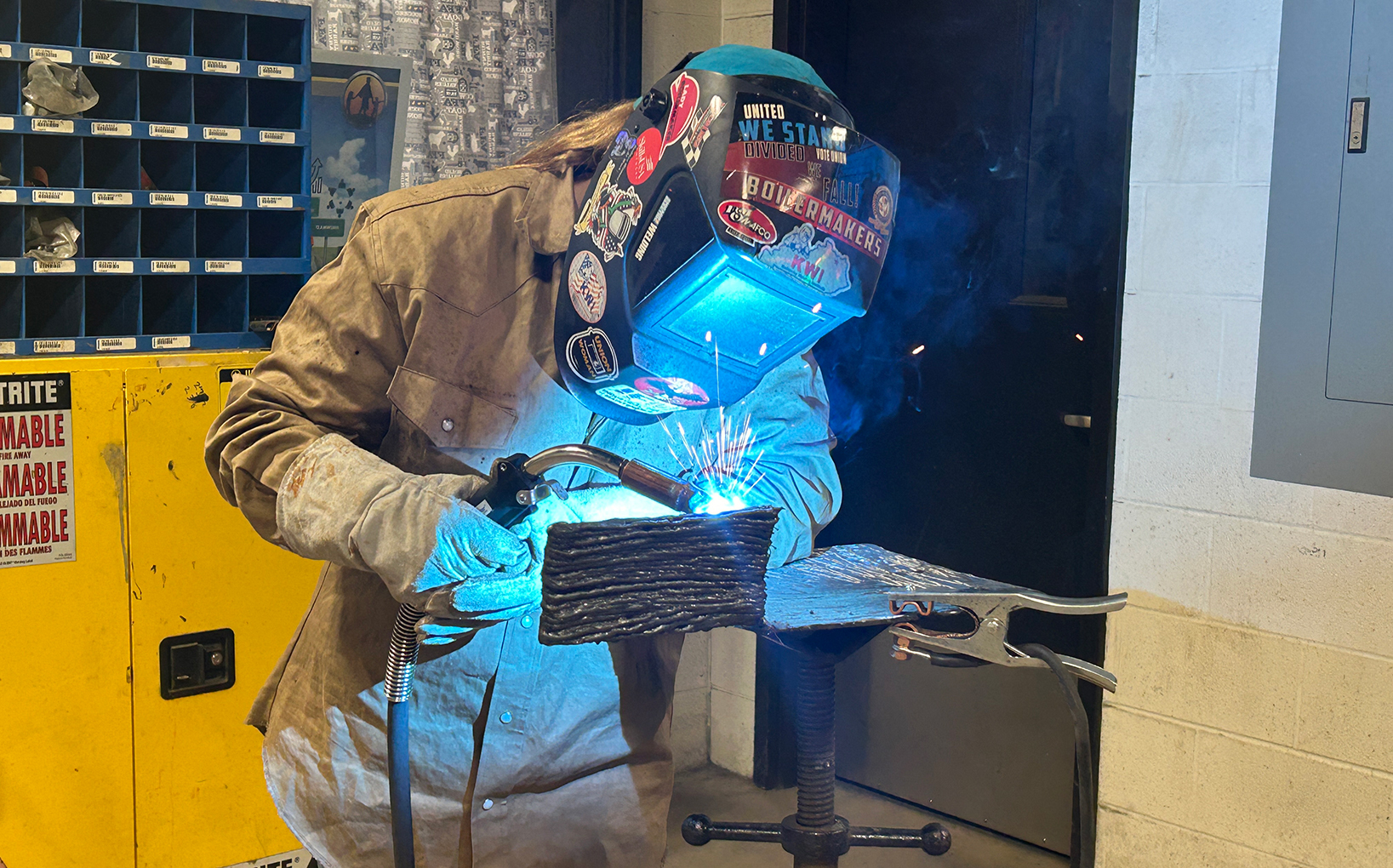
First-grade teacher Stephanie Maynard helps a group of Jefferson County Traditional Middle School students find new reading partners at Cochran Elementary School (Jefferson County). The middle school students wrote and illustrated their own books which they later read aloud to Cochran elementary students. Photo by Justin Willis, March 6, 2012
By Matthew Tungate
matthew.tungate@education.ky.gov
Students in Willetta Stephens’ 2nd-grade class at Cochran Elementary School (Jefferson County) received a special treat last week when hundreds of children’s book authors visited their school.
Before the authors arrived, Stephens told the students they would be “amazed” at the books the authors were bringing.
The 25-year teaching veteran asked her students to pay special attention to the setting in the books and to ask questions about the writing process. She also told them the authors had rewritten their books several times – a sticking point with 2nd graders who don’t believe in the “good writing is rewriting” adage.
When the authors arrived, most were able to read one-on-one with students in Stephens’ class as well as students in other classrooms.
That’s because the authors were 138 7th graders in Donna Duvall’s English/language arts classes at Jefferson County Traditional Middle School (JCTMS). All of the middle school students had written and illustrated books for 5- to 8-year-olds. Their visit to Cochran was the culmination of their project.
This is the second year Duvall’s 7th graders have written and illustrate children’s books to read at Cochran Elementary. The 17-year teaching veteran said she wanted to give her students an opportunity to write for a “real” audience.
“The more the writing can be real, the more the students will be inspired,” Duvall said. “We all want to be heard – and this age group especially wants to be heard.”
Having an audience that you’re more knowledgeable than gives you a comfort level, she said.
“When they reach a different kind of audience that’s not grading them, then they tend to write things they would never have written if they thought somebody their own age was going to read and criticize,” Duvall said.
Authoring a children’s book is not easy, she said. Duvall required her students to produce 16- to 32-page books with stories and illustrations that could respectively tell the tale.
She started by having her students review children’s books from her classroom and that came from Sue Wagner, the Family Resource and Youth Service Center coordinator at both Cochran Elementary and JCTMS, who helped coordinate the collaboration.
Duvall said her students analyzed the writing of many of the books to understand why they work for younger audiences. Then the school’s librarian, Emily Grady, read them out loud so the students could see how inflection plays a part in reading to children.
The librarian also showed students how to do some illustration, such as how to draw movement and facial expressions to help tell the story.
Duvall said wanted the students to pre-write using an outline – but first she had to teach them how to do an outline. Students then wrote four or five versions of their stories, she said.
Once the stories were complete, the students had to break the text into pages and do the illustrations. That required a lesson about how art isn’t perfect, Duvall said.
“We learned how to forget there was a mistake and let it go,” she said.
Students also had to write a dedication and an “about the author” page in the third person.
Once the books were finished, she bound and laminated them. She had all of her students read their books at the same time so they could get over the awkward awareness of being overheard.
“It’s just amazing what it does for their self-confidence,” Duvall said.
The books are really a lesson for both the students and for teachers, she said.
“School is work. This is their job. They don’t get paid for it. Their reward is grades, and sometimes those grades are not very rewarding,” Duvall said. “For these students, when they go to the elementary school and read their books, they’re all going to be rewarded for their work by the reaction of their readers.”
Duvall said she was impressed by how passionate some of her students became about the books.
“I had some kids that are C students who wanted to do 32 pages,” she said. “Some of my students that normally could not write very well have really come up with some clever, funny little stories because they’re very visual. So it reaches another one of their ways of learning.
“It’s great to see a student who is sort of struggling to feel good about writing.”
Elementary students get benefits, too
Duvall said she has a picture from last year of a tall middle school boy reading to an elementary school girl in his lap. Duvall said the girl is looking at the boy “like he hung the moon, and he is totally absorbed in reading that book to her.”
“These kids not only are modeling for them that kids can be authors, kids can write books, but that kids care about kids,” she said. “It’s not until after this that some of them will go, ‘I wish I had done better.’”
Last week, most elementary and middle school students sat in chairs at table next to each other. But there were some sitting on the floor or kneeling next to an open picture book. All of the rooms were abuzz with the chatter of children with broad smiles and wide eyes. Authors rotated among children in each room and often between rooms for the hour they were there.
Across the hallway from Stephanie Maynard’s 1st-grade room is a bulletin board with her students’ writing papers surrounding a sign that says, “We are STRONG writers!!”
Comments on the papers included:
“You found key details.”
“Good reason.”
“Good connection.”
“Great story.”
Maynard’s class participated in the project last year, and she said “it was beautiful. It was just wonderful.”
She said the middle schoolers set a good example for her young students, who are just learning to write.
“Those books are important,” Maynard said.
Seeing the middle school authors encourages her students to become good writers, too, she said.
“It’s that process that starts to click,” Maynard said.
Last year she was worried about giving up instructional time to let middle schoolers read to her students. She has since reconsidered.
“This is instruction. It’s just another version of it,” Maynard said. “It’s worth the time for sure.”
Stephens agreed. She has her students writing books – and that includes rewriting.
“I look forward to this time when the (older) students come because it reinforces what I’ve done,” she said.
When her 2nd graders see the older students with their finished products, it helps them understand the writing process, she said.
“They see a child can do this,” Stephens said.
After the middle school authors left, Stephens reviewed the morning’s events with her class.
They talked about how the books were big, accurate and colorful; how the pictures matched the words; that they had a beginning, middle and end; and they talked about the purpose and interpretation of the stories. Many of the students said their favorite was one about not listening to bullies.
“You see how the author can have a message to the story?” Stephens asked.
MORE INFO …
Donna Duvall, donna.duvall@jefferson.kyschools.us, (502) 485-8272









Leave A Comment